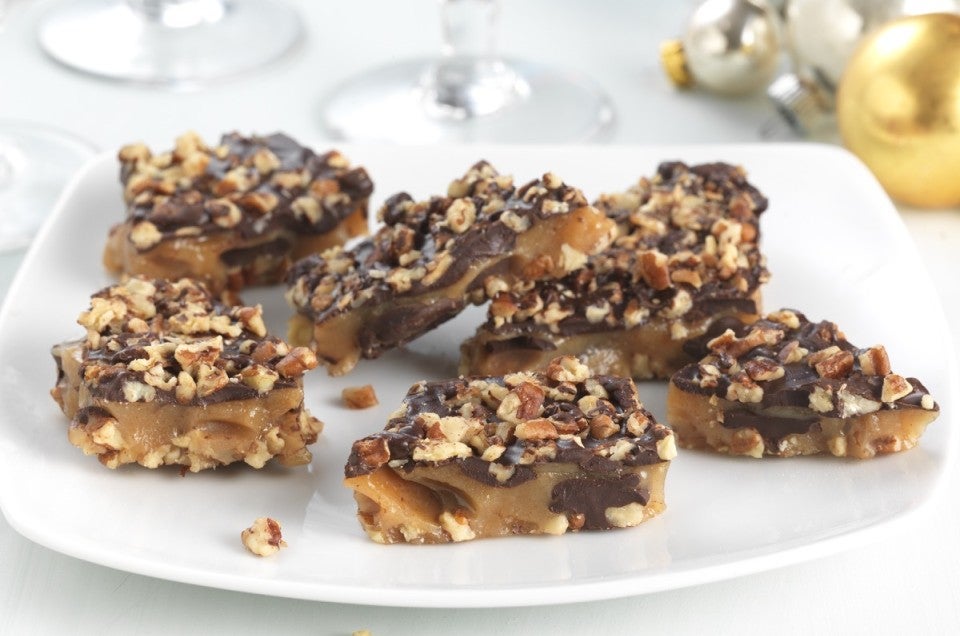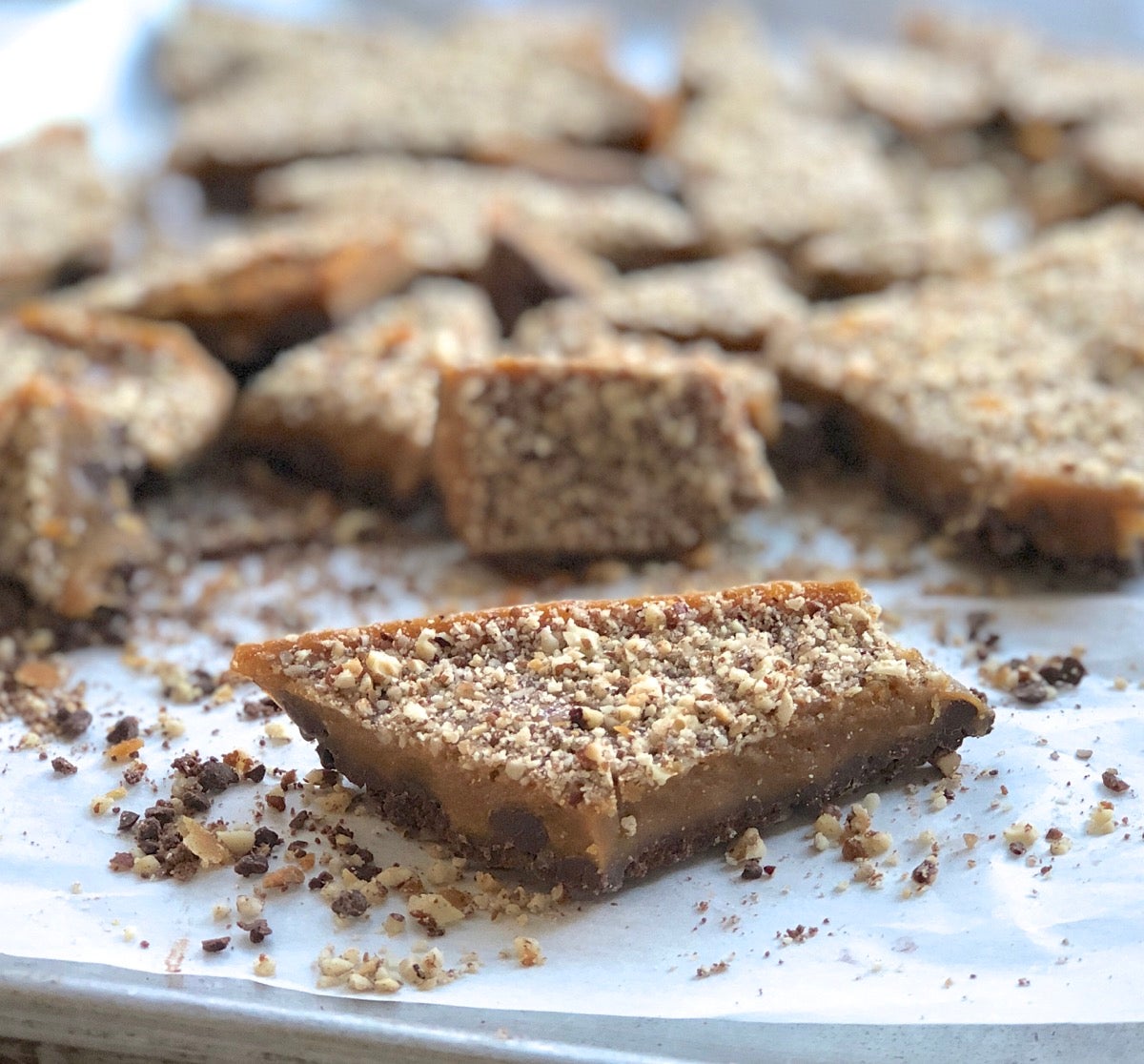


I have to admit, I’m the Grinch when it comes to decorated Christmas cookies. Rolling out dough has never been my favorite baking pastime. And while I’ll put up with rolling pastry when the end result is a warm slice of berry pie, sugar cookies shaped like reindeer just don’t have that same allure. Which is why, at this time of year, my thoughts turn to homemade candy: especially crunchy, Heath bar-like English toffee studded with chocolate and toasted nuts.
“I don’t make candy,” you say? Well, why ever not? It’s much simpler than just about any cookie you can make; it dirties one (count it, one) pan; and a little goes a long way. Make three or four or five different candies — say, English toffee, brittle, bark, fudge, and caramels or marshmallows — and you can easily fill a dozen gift bags.

Not only that: most candy can be made, wrapped, and stored for at least a couple of weeks prior to serving or giving it away. When you’re pressed for time (and who isn’t right about now?), a pantry stash of homemade candy is a lifesaver.
Unexpected guests? Send them home with a mini gift bag of homemade English toffee or fudge truffles (which you just happen to have on hand thanks to your exquisite pre-planning).
Now, let’s get down to brass tacks. What’s the one thing that stops most people from making candy that starts with cooked sugar syrup, like this English toffee?

Fear of boiling syrup.
People tend to be scared of hot syrup — and for good reason, since it can render a painful burn if you’re not careful.
But do you avoid using a knife for fear of cutting yourself? Never boil pasta because of its billowing steam? Handling a pot of simmering butter and sugar is worth the extra care when the end result is a delicious batch of holiday candy.

Nut-studded, chocolate-enrobed Dark Chocolate Buttercrunch is America's version of English toffee. And honestly, if I had to pick my favorite homemade candy — this is it.
The recipe couldn’t be simpler: Simmer butter, sugar, water, salt, and a touch of corn syrup; then combine the dark-gold syrup with toasted nuts and chocolate chips. Cool, break into pieces, and share with family and friends — all of whom will wax poetic about the joys of buttercrunch!
I always start with the buttercrunch recipe on our site, but over the years I’ve discovered some handy tips and have developed a few delicious modifications. Interested? Read on. 
While English toffee is already deeply caramelized and richly flavored, I like to add a teaspoon of espresso powder to the sugar for an extra note of flavor. I find the slight bitterness of espresso helps offset the sugar’s sweetness, and its very mild coffee flavor is a fine complement to the candy’s caramel notes.

Some people enjoy "blonde" toffee with just a hint of caramel; others cook their syrup to just short of burned, for candy with assertively caramelized flavor.
While you may gauge the syrup’s stage with a candy thermometer, your eyes are important too. Is the syrup pale as a palomino pony? Amber like maple syrup? Dark as autumn oak leaves? With experience, you’ll learn just how dark you like your candy — but you can only do this if you use a light-colored pan, one that doesn’t hide the syrup’s true color.

There’s nothing like the sight of bubbling syrup climbing up, up, up the sides of your saucepan. Is it going to stop — or spill over?
Help that syrup stay where it belongs by greasing the inside of your saucepan with vegetable oil pan spray before you start. Just like fairgoers grappling with the famous greased pole, syrup has difficulty climbing the sides of a greased pan.

Simmering the syrup for English toffee to the requisite 300°F temperature can (and should) be a slow process — up to 20 minutes or so. Don't hurry this gradual transformation; syrup that doesn't reach 300°F, or close to it, will make candy with timid flavor and chewy (not crunchy) texture.
Think you can save time by bringing the syrup to a full rolling, popping boil in order for it to darken more quickly? Think again. You're just setting yourself up for separation anxiety: i.e., the butter separating from the sugar and forming a recalcitrant oily mass — purely as a result of your haste!
Simmer the syrup vigorously, but don't cook it at such high heat that it looks like it's jumping out of its skin. Not only do you risk separation; it's very easy to create a smear of burned sugar on the bottom of the pot, which can and probably will turn the syrup (and your candy) bitter.
When I make buttercrunch, it typically takes about 15 minutes over medium heat to bring the syrup to 300°F. It goes slowly at first, but towards the end the temperature rises quickly; I watch it fairly closely once it gets to 280°F or so.
If you don't have a thermometer, you'll need to do the "hard crack" test. Dribble some syrup into ice water, and let it set for 10 seconds. Fish the hardened candy out of the water and test its texture. Is it crisp, not chewy? Does it snap cleanly, rather than bend? It's ready.

If you’ve ever added baking soda to simmering sugar syrup you’ve experienced the “excitement” of that sudden billow of bubbles. What’s going on? The base soda is reacting with the acid sugar, plus heat, to make tons of tiny bubbles. Those bubbles remain trapped in the syrup as it cools in the pan, yielding toffee whose consistency is lightly crunchy rather than hard: think light-textured American-style biscotti vs. rock-hard Italian-style.
Do you have to add baking soda to buttercrunch? No, not at all; in fact, our base recipe doesn’t call for it. But if you’re looking for candy whose crunch is light rather than "toothsome," do add a teaspoon of baking soda (you’ll find that option offered in the recipe).

Buttercrunch can be absolutely plain: just pour the syrup into the pan and Bob’s your uncle, you’re done. But most of us like to gussy it up, Heath bar-like, with chocolate and/or nuts. Here are some things to keep in mind.

I use pecans and almonds interchangeably. Flavor-wise, they’re both good fits. Want to use walnuts? Macadamias? Pistachios? Totally your choice.
Whatever you choose, it’s best to toast the nuts first to bring out their flavor. I bake them for about 8 minutes at 350°F in my toaster oven, but use whatever method's your favorite; your goal is golden-brown nuts.
Also, dice the nuts fairly fine, since this makes it easier to break the candy into smaller pieces.

I’ve been known to grind the toasted nuts and press them onto the top of the hot candy, for a smoother appearance without any compromise in flavor. (If you think you need it, put a layer of parchment between you and the nuts/toffee to protect your fingers as you press.)
As for chocolate, the Baking Police say go right ahead, use milk chocolate or white chocolate (or no chocolate) if that's your preference. Bailey's Irish Cream chips? Genius!
Do you like a thin layer of toffee sandwiched between a generous amount of chocolate and nuts? Or do you prefer a thicker layer of toffee, with the other elements providing a welcome counterpoint without taking over? The choice is yours.
Our original buttercrunch recipe calls for toffee enrobed in a generous amount of both chocolate and nuts, top and bottom.

I prefer a less decadent version: I cut the amount of both chocolate and nuts in half, using chocolate chips below the toffee, nuts on top.

For toffee with chunks of chocolate embedded in the bottom, I use whole chips (left, above). For a more even layer of chocolate, I process the chips briefly in a food processor (right, above); I don't want them ground to powder, just broken up.

I pour the syrup into a 9” square pan rather than freeform it onto a baking sheet, so the layer of toffee is uniform. Lining the pan with a parchment "sling" makes it easy to lift the candy out once it's set.
Now, some folks like nuts on the bottom, chocolate on top, with perhaps a scattering of nuts atop the chocolate.
Some people stir the nuts into the syrup before pouring it into/onto the pan, then sprinkle chocolate chips on top, smearing them to cover as they soften and melt.
And yes, some folks eschew either chocolate or nuts entirely; really, this is all up to you. Don't imitate the old carthorse trudging its well-traveled milk route; use your imagination!

Whatever you choose to make in your kitchen this holiday, if you wrap it up and give it with love you just can't go wrong.
Here are the candies I'm making over the next couple of weeks: Microwave Peanut Brittle, Choco-Mallow, Peppermint Crunch Bark, Apple Cider Caramels, and Deluxe Chocolate Truffles. How about you — any candy-making in your near future?